Saving the harvest from uninvited guests: how to find out who is nibbling beets in the garden and defeating the pest quickly and easily
What could be tastier than homemade borscht or beetroot vinaigrette grown in your own garden? Digging up the soil and planting seeds is only part of the work towards a rich harvest. The most important care occurs during the beet growth process.
At this time, a completely undesirable phenomenon for gardeners often occurs - an invasion of pests. Insects, worms, and rodents appear and destroy the crop. Already at the germination stage, they are able to deprive their owners of the freshest beetroot salad with garlic. How to prevent this, read our article.
Beet pests and ways to combat them
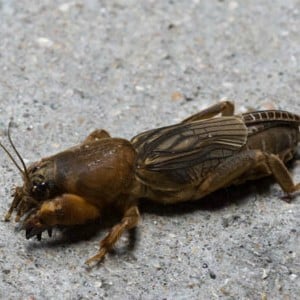
Harmful insects are the main enemy of the crop. Beets are among the favorites of pests - they are a favorite food of many insects. Any garden owner, having discovered a poor-quality harvest or its signs, wants to know who is gnawing on the beets in the garden.
Let's find out how to recognize pests and fight them.
Medvedka
One of the most dangerous pests in the garden. The mole cricket is a large brown beetle with a hard shell and antennae. The insect can grow up to 10 cm in length. With its powerful jaws it is capable of gnawing root crops in the ground.
The mole cricket reproduces quickly, and its larvae cause no less damage to fruits than adults. There are two ways to get rid of the mole cricket: by spilling its holes or using chemicals.

Nematode
This is a worm that lives in the earth.It causes serious damage to root crops by eating them directly in the soil. As a result, the beets slow down in development and quickly die.
Farmers recommend pouring boiling water over the soil before planting beets. High temperatures kill nematodes.
If the worm is found during beet growth, chemicals will help.
Beet fly

An equally dangerous enemy of beets, which lives on weeds, but then moves onto cultivated plants. This fly eats beet tops.
Suddenly dried beet leaves are a sure sign of beet fly. If you look at the inside of the leaf, you can find transparent larvae that look like caterpillars. This is a characteristic sign of a beet fly infestation.
Affected beet leaves must be removed and an insecticide applied.
Beet bug

The bug, like the beet fly, moves onto growing vegetables from weeds. Therefore, the best way to combat it is to destroy weeds near the beds and around the garden.
The bug is barely visible to the naked eye, but eats up to five times its body weight.
A distinctive sign of a bug attack is the bubbly surface of beet leaves. Bedbugs are also destroyed with insecticides.
Mining moth
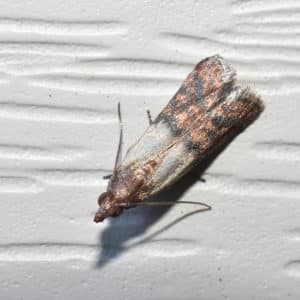
At first glance, the small brown butterfly does not arouse suspicion. However, moths can completely destroy a crop. She lays eggs on the cuttings of beet leaves, and the caterpillars begin to gnaw their way into the root crop itself.
There are three types of leafminer moths - tomato, chestnut and apple leafminers. It appears in the garden if there are corresponding plants nearby. And it is necessary to treat exactly the place of origin of the moth.
If you notice affected leaves on these trees or bushes, cut and burn. In this way, further reproduction of the insect will be avoided.
Beet root aphid
Small insects with a round yellow body. A characteristic feature of the appearance of aphids is a white mold coating on the ground around the fruit.
When the pest actively reproduces, the beet leaves dry out and the plant dies. One of the most successful ways to control aphids is by removing weeds and using insecticides.
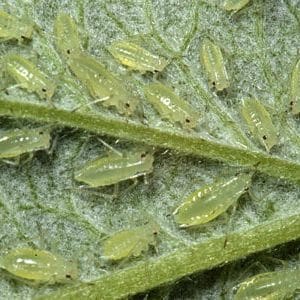
Beet flea beetle
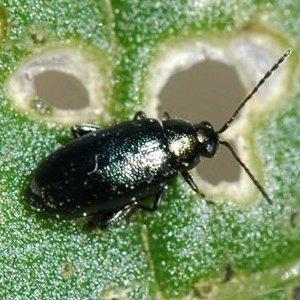
It is a small beetle from the subfamily of flea beetles. Mass reproduction occurs in dry weather. A clear sign of flea beetles is holes in beet leaves.
Preventative measures – weed removal. If you find bugs on the leaves, use chemicals to treat the tops.
Beet weevil
This is a small black and beige beetle. The weevil lays its larvae in the ground. The larva formed from the pupa in the ground goes straight to the root of the beet. Beetles are easy to spot.
The dangerous amount per square meter is from 2 to 4 pieces. In this case, drastic measures are needed: completely get rid of the weeds around, examine the entire beet harvest. At the specified concentration of beetles, insecticides are used.

Beet beetleaf
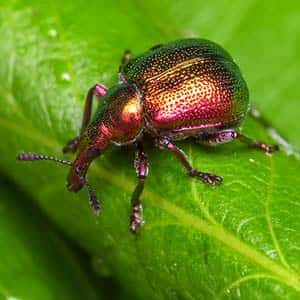
Small but harmful bugs feed on beet tops. A distinctive sign of a beetroot beetle infestation is the “lace” on beet leaves.
By eating and gnawing leaves, the insect harms the root crops themselves.
The main rule in the fight against bugs is early and regular weeding of beet beds to remove weeds.
If damage has already been done to the tops, use chemicals.
Insect pests have appeared, what to do?
Damage from beet-loving insects is easy to notice. Inspecting the plants daily, an attentive owner will notice the distinctive features of a damaged vegetable:
- dry or yellowed tops;
- deformed leaves: holes, cut edges, bubbles;
- developmental delay;
- holes in the garden bed;
- visible larvae, beetles, moths.
These signs indicate that urgent measures are needed to preserve the beet harvest. If you have already identified the type of pest, dealing with it will be much easier. However, there are also universal methods of struggle.
Insecticides
Or chemicals that can instantly save your beets from pest attacks. An effective and quick way to preserve the future harvest. The most popular among them:
- emulsion solution of 40% “Phosfamide” (treated once every 10 days);
- “Tayra” (sprayed with the product once every 14 days);
- “Sirocco” (sprayed with the product once every 14 days);
- "Avant" (processed every 10-14 days).
Folk remedies
Many of them are used already at the planting stage. There is no 100% guarantee of victory over pests, but it’s worth a try:
- an aqueous solution of ash in a ratio of 1:10 (spray around the beets);
- spraying tobacco dust;
- destruction of ants around (they give rise to aphids);
- planting corn, potatoes, peas, marigolds near beet beds;
- water (rinse the beet leaves with a hose);
- onion infusion (30 onions per 1 liter of water, leave for 5 hours and spray the beets 2-3 times a week);
- soap-soda solution (add a quarter of crushed laundry soap and 20 g of soda ash to 1 liter of water, spray 2-3 times a week).
Mice gnaw beets in the garden
In addition to insect pests, field mice pose a danger to beets.
Signs of voles
You can determine that there is an uninvited guest in the garden by the presence of holes and paths shallow in the ground. Mice have rather small claws, so they cannot dig deep passages. However, they easily eat root vegetables and beet tops.
How to protect beets in the garden from rodents
There are several simple ways to deal with them:
- Cats and cats. Mice are afraid of cats by nature, and, sensing their smell, they avoid the garden. Get a simple village cat and forget about the problem with mice.
- Sprinkling beds with ash. Mice can't stand her.
- Digging the earth in the fall so that not a single mouse path remains.
- Clear the garden area of plant debris in the fall. If you don't leave anything, the mice will have no food reserves in the winter. Mice will leave your area in search of food.
If these methods do not help you, and mice are already in charge of the beet beds, try other methods, such as:
- ultrasonic repellers;
- electromagnetic repellers;
- traps;
- special poisons for rodents.
Be sure to read the instructions for each product.
Pest Control Rules
Prevention in the fight against all types of pests is standard agrotechnical measures for pre-sowing preparation, planting and cultivation:
- thorough digging with the removal of plant remains in autumn and spring;
- fertilizer earth universal vitamins;
- do not add fresh manure when growing beets;
- watering the beds with a solution of potassium permanganate or hot water;
- loosening and weeding;
- timely watering;
- when pests appear, treat the plantings with approved preparations;
- Dry the harvested beets well before storing them and inspect them for signs of root rot.
Tips and tricks
To avoid disappointment when harvesting:
- follow preventive measures to combat all types of beet pests;
- learn to identify pests so you can use the most effective methods;
- always have insecticides in your arsenal and find out in advance how to use them;
- remember - the beet harvest also depends on the condition of your garden as a whole (neighboring beds and the surrounding area of the garden);
- regularly check the condition of root crops in the garden;
- pay special attention to harvesting and storing crops;
- prepare future beds in the fall.
Reviews from gardeners
Many gardeners have already become “acquainted” with pests in their gardens:
Antonina, Moscow region: “I noticed that mice eat beets in the beds. I got a gray cat who started hunting at night. After a week I didn’t notice a single mouse anymore.”
Nina Ivanovna, Tula: “A mole cricket appeared at my dacha. It had never happened before, but now it started literally eating my beets. I saw her crawl into a hole. I watered the holes with Tyra, and the mole cricket was gone. By the way, now I regularly completely cultivate my garden around the vegetable garden.”
Petr Vasilievich, Kaluga: “At first I didn’t understand who was eating beets in the ground. At first I thought it was a mouse. I began to study photos of pests and realized that they were beet aphids. First I started cutting off the eaten leaves, then I decided to make an onion solution. I never saw that crap again."
Read also:
Why do gardeners prefer the beet hybrid “Vodan f1”.
Favorite by farmers for its ease of care and taste, the “Cylinder” variety of table beets.
Conclusion
Every garden owner dreams of getting a healthy and high-quality harvest that will delight his family in the fall and winter.Unfortunately, pests get in the way of delicious beet dishes. Almost all garden owners encounter them.
Compliance with the rules of soil preparation, care and care of root crops throughout their growth is the key to a successful harvest. Take care of beets, and delicious dishes made from this root vegetable will delight you all autumn and winter.
Half a beetroot was eaten. Who is this?
Some kind of mole cricket - they love to gnaw on roots.
The same trouble struck our dacha, they ate young leaves of beets, carrots, and cabbage... we decided to put 4 traps for smoked meats. On the first day, four wild huge hamsters were caught. On the second day, 3 magpies were caught, and on the third day, 3 traps worked, and on the 4th, a hamster was caught again. It quieted down a little... the beets began to rise and grow again... but the cabbage, which I replanted 2 times, sent out shoots 2 and 2 times. 3 swings. I don't know if it will grow?
Last fall, at the dacha, some rodents destroyed 50% of the harvest of beets and carrots right in the beds, gnawed everything above the ground and gnawed 2-3 cm into the ground. And the onions were eaten away, leaving only one shell, but not in the garden, but already in the barn to dry.